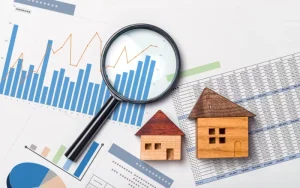
Commercial property analysis is a crucial aspect of real estate investing, providing insights into a property’s potential profitability and value. Investors rely on various financial metrics to make informed decisions about buying, selling, or managing commercial properties. Understanding the key financial considerations, such as cash flow analysis, Net Operating Income (NOI), and capitalization rate (cap rate), is essential for evaluating the risks and returns of a commercial real estate investment.
In this article, we will explore the top financial considerations that investors should keep in mind when analyzing commercial properties to ensure strategic and profitable investment outcomes.
What Is Commercial Property Analysis?
Commercial property analysis involves evaluating various aspects of a commercial real estate asset to determine its potential profitability and investment value. This analysis includes examining market trends, property conditions, financial performance, and location attributes.
Key components often reviewed are rental income, occupancy rates, comparable property values, and operating expenses. The goal is to provide investors with a clear understanding of the property’s strengths and weaknesses, helping them make informed decisions about purchasing, selling, or managing commercial real estate.
Financial Considerations in Commercial Property Analysis
There are several financial considerations in commercial property analysis that are essential for making informed investment decisions. These factors help investors evaluate the potential profitability and risks associated with a property. Understanding these considerations can lead to better investment outcomes and strategic planning.
Cash Flow Analysis
Cash flow analysis involves examining the net income generated from a commercial property after deducting all expenses, including operating costs, taxes, and mortgage payments. Positive cash flow signifies that the property is generating more income than expenses, making it a profitable investment.
Net Operating Income (NOI)
Net Operating Income is a key metric that measures the profitability of a commercial property. It is calculated by subtracting operating expenses from the gross income. NOI helps investors assess the income potential of a property, excluding financing and tax considerations, providing a clear picture of its operational performance.
Capitalization Rate (Cap Rate)
The capitalization rate is a critical measure used to evaluate the return on investment for a commercial property. It is calculated by dividing the Net Operating Income by the property’s current market value. A higher cap rate suggests a higher return on investment, while a lower cap rate indicates lower returns and potentially higher risk.
Loan-to-Value Ratio (LTV)
The Loan-to-Value ratio is a financial metric that compares the amount of a property loan to its appraised value. A lower LTV ratio indicates less risk for lenders and can result in more promising loan terms. It also signifies a higher equity stake for the investor, reducing the risk associated with the investment.
Debt Service Coverage Ratio (DSCR)
The Debt Service Coverage Ratio (DSCR) assesses a property’s capacity to produce enough income to meet its debt obligations. This ratio is computed by dividing the Net Operating Income by the total debt service. A DSCR above 1 signifies that the property generates adequate income to cover its debt payments, thereby minimizing the risk for lenders and investors.
Market Trends and Forecasts
Understanding market trends and forecasts is crucial for commercial property analysis. This involves studying economic indicators, local real estate trends, and future developments that could influence property values and rental rates. Staying informed about market conditions helps investors make strategic decisions and anticipate potential changes in property performance.
Tenant Creditworthiness
Evaluating the creditworthiness of potential tenants is essential for ensuring stable rental income. This involves assessing the financial health, business history, and payment reliability of tenants. High-quality tenants with strong credit ratings reduce the risk of rent defaults and contribute to a steady income stream for the property owner.
Expense Management
Effective expense management is vital for maximizing the profitability of a commercial property. This includes regularly reviewing and optimizing operating expenses, such as maintenance, utilities, and property management fees. Keeping expenses under control helps improve the Net Operating Income and overall financial performance of the property.
Frequently Asked Questions

How do operating expenses influence the financial performance of a commercial property?
Operating expenses, including maintenance, utilities, insurance, and property management fees, directly affect the Net Operating Income (NOI). Efficiently managing and minimizing these expenses can improve profitability, making the property more attractive to investors and lenders.
How do comparable property values influence investment decisions?
Comparable property values provide a benchmark for assessing a property’s market value. By analyzing recent sales of similar properties in the area, investors can determine if a property is priced fairly and gauge its potential for appreciation.
What role do market trends play in commercial property analysis?
Market trends play a significant role in property analysis by influencing property values, rental rates, and investment potential. Staying informed about current and projected market conditions helps investors make strategic decisions. Examining commercial property listings within trending markets can reveal opportunities for growth and higher returns.
Conclusion
Understanding the top financial considerations in commercial property analysis is essential for making informed investment decisions. By evaluating cash flow, Net Operating Income, cap rate, and other key metrics, investors can strategically assess the profitability and risks associated with commercial real estate properties.
Ready to invest in commercial real estate? Contact us at 3D Real Estate, a commercial real estate broker in Littleton, CO, for expert assistance in buying or selling property. Let us help you achieve your investment goals.




